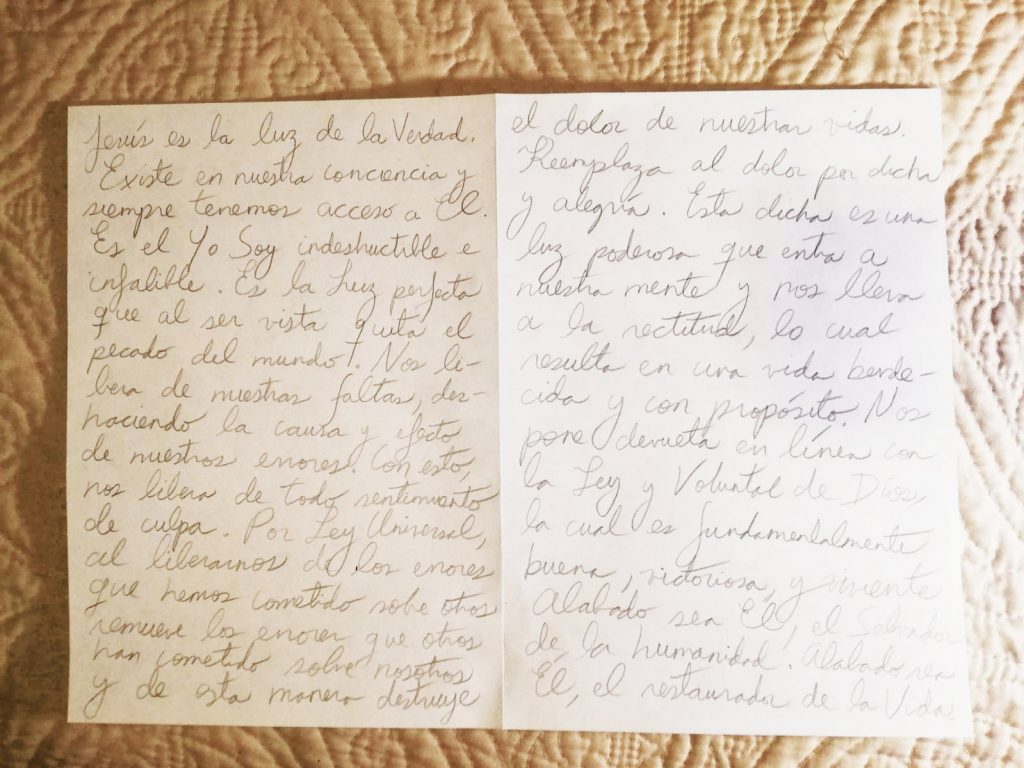
Image of the devotional spontaneous text I did for this task.
The Art of Handwriting
This task brought me back to early 2020 when, for a few months, I was working on a project of devotional writing. Even though these writings were planned to be released digitally, I would do the writing process by hand, using a pencil and paper. As Collier notes in Cooke’s (2012) short film, there was a therapeutic and more intimate aspect to bringing thoughts into form through writing than typing. I would write about three to four devotional papers a day and soon begun to make some connections between handwriting and art. I noted that writing words is a form of visual art in the sense that you can do beautiful handwriting. As I practiced my writing daily, I became intensely aware of how I wrote the letter of every single word. I realized it was very similar to the process of signing, in which every single note of a melody has to be carefully located on the right pitch. I understood that if I took a “one letter at a time” approach while writing, the words I produced came clear and visually appealing, which is closely related to what Collier (Cooke, 2012) referred to as “putting the letters together”. This is certainly not present in the production of writing digitally in which a letter is produced by hitting a key. In that regard, writing puts us in a position of a designer or artist which is lost when we type. Bolter (2001) observed that each new technology claims to be better than the one it sets out to remediate in at least one—if not several—senses (p. 26), however, I think this is not correct, but rather depends on how we look at it. From a practical point of view, typing is better because it saves us time, but isn’t our ability to produce beauty and experience it essential for a good life as well? Of course, this all depends on the context and purpose of putting ideas into form.
As I became more proficient at handwriting I began to see them as pieces of music or art. The inspiration of a session plus the writing technique would make these “shinny” (beautiful) objects that contain the “wow factor” described by Collier (Cooke, 2012). I could see that, just as in singing, they were a performance that couldn’t be reproduced in any other way – a unique creation that reflects the inner emotional state of the writer, not only in the words and ideas but also in the visual production of the words. What I found particularly surprising about doing this task (in which I wrote again a devotional text) is that, compared to my writing in early 2020, I felt a little out of shape. This revealed more connections between art and writing because it made me reflect on the importance of practice. I know that when you stop practicing a musical instrument or singing for a long time, it might take you some time to get back to the top of your game. However, it is also interesting to see that the technique is also retained to some degree, so I was able to write within standards of what I consider beautiful.
References
Bolter, Jay David. (2001). Writing space: Computers, hypertext, and the remediation of print [2nd edition]. Mahwah, NJ: Lawrence Erlbaum.
Cooke, Danny (2012). Upside Down, Left To Right: A Letterpress Film [Video file]. YouTube. https://www.youtube.com/watch?v=n6RqWe1bFpM&ab_channel=DannyCookeFreelanceFilmmaker